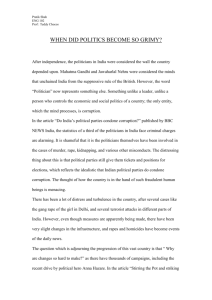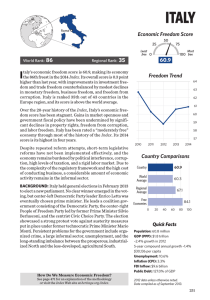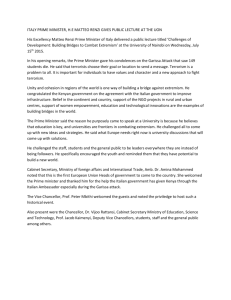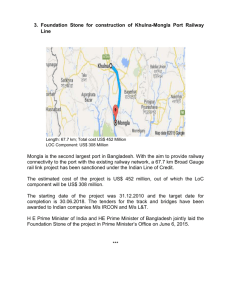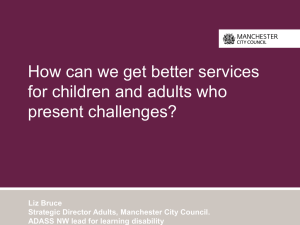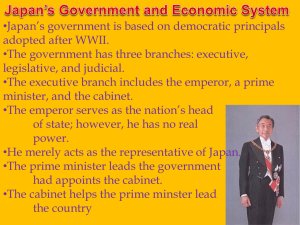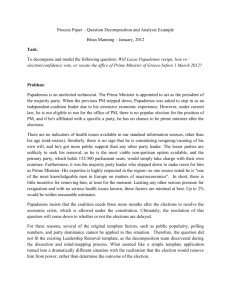Government in Search of Leaders
advertisement
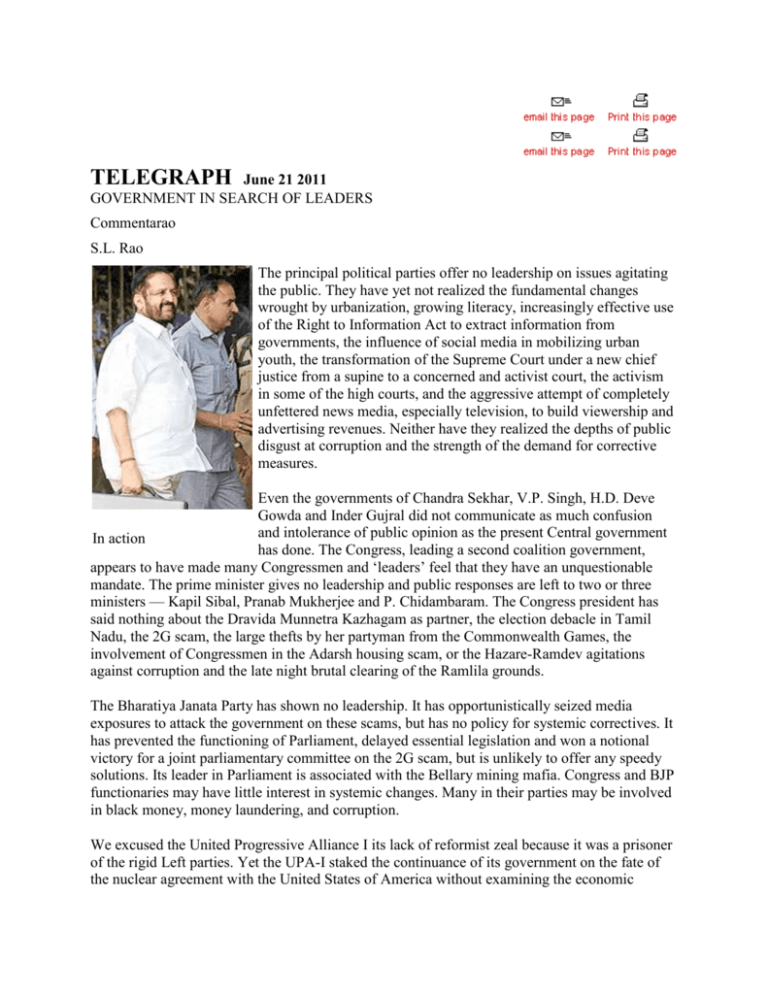
TELEGRAPH June 21 2011 GOVERNMENT IN SEARCH OF LEADERS Commentarao S.L. Rao The principal political parties offer no leadership on issues agitating the public. They have yet not realized the fundamental changes wrought by urbanization, growing literacy, increasingly effective use of the Right to Information Act to extract information from governments, the influence of social media in mobilizing urban youth, the transformation of the Supreme Court under a new chief justice from a supine to a concerned and activist court, the activism in some of the high courts, and the aggressive attempt of completely unfettered news media, especially television, to build viewership and advertising revenues. Neither have they realized the depths of public disgust at corruption and the strength of the demand for corrective measures. Even the governments of Chandra Sekhar, V.P. Singh, H.D. Deve Gowda and Inder Gujral did not communicate as much confusion and intolerance of public opinion as the present Central government In action has done. The Congress, leading a second coalition government, appears to have made many Congressmen and ‘leaders’ feel that they have an unquestionable mandate. The prime minister gives no leadership and public responses are left to two or three ministers — Kapil Sibal, Pranab Mukherjee and P. Chidambaram. The Congress president has said nothing about the Dravida Munnetra Kazhagam as partner, the election debacle in Tamil Nadu, the 2G scam, the large thefts by her partyman from the Commonwealth Games, the involvement of Congressmen in the Adarsh housing scam, or the Hazare-Ramdev agitations against corruption and the late night brutal clearing of the Ramlila grounds. The Bharatiya Janata Party has shown no leadership. It has opportunistically seized media exposures to attack the government on these scams, but has no policy for systemic correctives. It has prevented the functioning of Parliament, delayed essential legislation and won a notional victory for a joint parliamentary committee on the 2G scam, but is unlikely to offer any speedy solutions. Its leader in Parliament is associated with the Bellary mining mafia. Congress and BJP functionaries may have little interest in systemic changes. Many in their parties may be involved in black money, money laundering, and corruption. We excused the United Progressive Alliance I its lack of reformist zeal because it was a prisoner of the rigid Left parties. Yet the UPA-I staked the continuance of its government on the fate of the nuclear agreement with the United States of America without examining the economic viability of nuclear energy in India. The Indian consumer does not pay full costs of electricity, and the present actual costs of nuclear energy are much higher than disclosed. For this agreement, Parliament was treated to the obscene display of vast sums of cash paid to some members of parliament for switching votes in favour of the government. This was a signal of the UPA’s lack of moral fibre and its willingness to stoop to any level to achieve its ends. The UPAII showed the same qualities in dealing with Anna Hazare and Baba Ramdev. (No one yet knows whose money was shown in Parliament.) The UPA-II was expected to unleash the reformist and social welfare zeal of Manmohan Singh and Sonia Gandhi. Instead, it has presided over the unabashed loot of vast amounts of national resources by people in power. It blatantly disregarded continuous detailed media exposures of the different loot, and the looters who were named, their modus operandi, and the estimated looted amounts. At no time was there even a semblance of preemptive action, either from the prime minister or the leader of the party. The prime minister ignored warnings to tackle double-digit food inflation because it might hurt growth. The government encouraged volatile foreign exchange inflows and did not close the loopholes that helped black money to go abroad, return to be laundered, make a profit and help save on tax. Beneficiaries must have included politicians, bureaucrats and businessmen. Growth was paramount, not peoples’ suffering or the looting of the nation. Continuing double-digit food inflation, growing income inequalities and obscenely lavish personal expenditure in the midst of mass poverty, created a growing public resistance to corruption. Both government and Opposition failed to appreciate this. The mixture awaited a Gandhian-style leadership. Anna Hazare provided it. The government dropped the minister, Mani Shankar Aiyer, who questioned the enormous and escalating expenditures on the Commonwealth Games, wanted the chairman, Suresh Kalmadi, removed and the budgets pruned. He was replaced by an ex-bureaucrat, unconcerned about the corruption, creating the climate for Hazare. Hazare defined himself and his movement clearly. He wanted to eradicate corruption with strong legislation and institutions. The lok pal bill was only one among them. He did not belong to any political group or support any individual. If any supporter was found flawed, he would be subject to the law. If the government would not respond, he would use Gandhian methods of nonviolent satyagraha and fasting to compel action. These are legitimate tools in a democracy to make governments behave. His method and leadership evoked a massive response in urban India but the rural and the less educated also watched with interest. Anna Hazare’s mistake was in not building cadres around the country and making more use of the internet to attract followers and funds. He may do so now since the government and Opposition are unwilling to draft strong legislation. Baba Ramdev, a great yoga teacher but an otherwise confused individual with a non-transparent past expected his yoga students to become his crusaders in a political movement. Shrewd ministers manipulated him to divide the anti-corruption campaign of Hazare through flattery and insincere promises. They played on Ramdev’s lack of clear objectives, knowledgeable advisors, craze for media appearances and for being the Leader. Instead of systemic changes to tackle corruption their attempt was to discredit the anti-corruption movement and Hazare, who was weakened by Ramdev and government tactics. But Hazare’s reputation is intact and we can expect years of agitation. Clearly, the government and the Congress wanted to prevent the rise of “civil society” leaders. In marginalizing Ramdev, the UPA government and the Congress were insincere about tackling corruption. This is reinforced by the weight of top ministers used to destroy Ramdev and the lack of it in negotiating with Hazare. The prime minister showed utterly confused leadership in selecting his top negotiator and dealing with the whole situation. Ramdev was looking for commitments, however foolish; the government was aiming to send him home. The subsequent unleashing of police brutality on an unwary sleeping crowd at the Ramlila grounds will haunt the UPA in the next elections. With Anna Hazare, the prime minister is even more confused. His minions are against the ‘tyranny’ of an unelected civilian, forgetting that this is a democracy and the government serves civilians. If the Congress wants to survive the disgraces of 2010 and 2011, it must find a new, younger, experienced, political, prime minister. In the process the family will be marginalized, and rightly so, allowing the Congress to get inner party democracy. The BJP must also develop an agenda for itself and stick to it. It must get politically experienced leaders who have run governments. Its present leadership cannot offer consistent and well-crafted opposition. India today suffers from a comprehensive failure of leadership in government and political governance. (The author is former director general, National Council for Applied Economic Research
